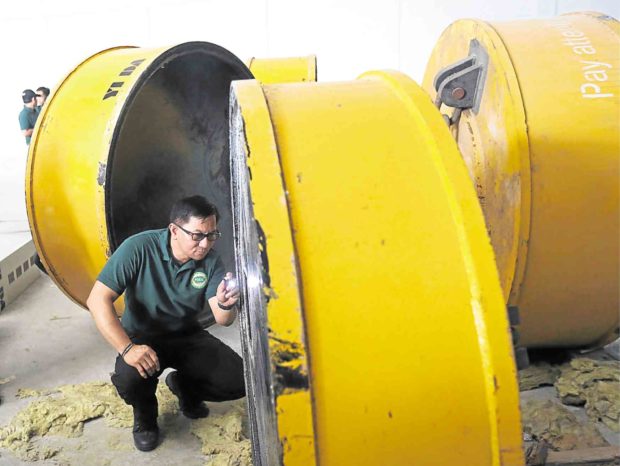Blame game starts in issue of smuggled ‘shabu’ worth P6.8 billion

PDEA chief Aaron Aquino inspects one of four magnetic lifters that contained traces of “shabu” (crystal meth) already emptied by drug traders that smuggled about P6.8 billion of the illegal drug in a Cavite warehouse on Friday. Authorities found the massive steel devices with hollowed parts where the drugs were hidden inside a warehouse in General Mariano Alvarez town in a follow-up operation after seizing 500 kilograms of shabu worth P4.3 billion (below) inside two lifters at the international container port in Manila two days earlier. (Photo by EDWIN BACASMAS)
And now the blame game begins in the issue of how P6.8 billion worth of crystal meth, or shabu, slipped through the Manila International Container Port (MICP).
On Saturday, Customs Commissioner Isidro Lapeña said the Bureau of Customs, if only given “timely” information, could have halted the release of the one-ton shipment, the discovery of which was revealed a day before by the Philippine Drug Enforcement Agency (PDEA).
“Our mechanisms are in place. I would have immediately alerted all those shipments, and if necessary, the entire port to prevent the release of illegal drugs,” Lapeña said.
On Friday, PDEA Director General Aaron Aquino said that an estimated P6.8 billion worth of shabu was already circulating in the streets after he and his agents discovered four magnetic lifters believed to have contained the illegal drug in a warehouse in General Mariano Alvarez in Cavite province.
The discovery came three days after the BOC seized an abandoned container at the MICP. The container had two magnetic lifters filled with 500 kilograms of shabu valued at P4.3 billion.
The shipment was consigned to Vecaba Trading International and was classified as abandoned after sitting at the port for a month.
Aquino said on Tuesday that he had a “gut feeling” that a similar scheme was used to slip in illegal drugs into the country.
Authorities, however, learned of the magnetic lifters in Cavite after the warehouse caretaker saw the report on the customs seizure and told police of what he suspected might have been the same modus.
Based on their backtracking of the Cavite shipment, customs spokesperson Erastus Austria said this arrived at the MICP from Taiwan on July 11.
The shipment, consigned to SMYD Trading, was declared to contain magnetic lifters and was red-tagged by the BOC. This means that it underwent a “nonintrusive examination.”
Austria said that the MICP released the shipment on July 14 after X-ray images showed that it did contain magnetic lifters and that its duties and taxes amounting to P157,673 had already been paid.
He added that because they did not receive any prior intelligence that the shipment contained illegal drugs, it was “impossible” for their personnel to determine its contents.
In fact, he pointed out that before they punctured the two magnetic lifters they seized, PDEA’s K-9 units were unable to determine it had illegal drugs.
When asked of the apparent intelligence gap between the two agencies, Lapeña, who once served as PDEA chief, said he understood some information are classified as “need to know.”
“But when the need crops up, the person who should know should be involved,” he said.
While Lapeña said that there may be erring customs personnel, he stressed the importance of intelligence sharing among agencies.
“I am fully aware and know the challenges and difficulties in running after these drug syndicates,” he said. “However, I would like to state that paramount in increasing our effectiveness in carrying out our mandate of border protection in the suppression and prevention of smuggling of any commodity is the timely receipt of intelligence information from the lead agencies tasked to eliminate illegal drugs in the country, and the close coordination with proper authorities between agencies.”
On the Vecaba shipment, Lapeña said he learned only of the “full details” of it on Aug. 4. He added that the public might not “possibly” have known of the SMYD shipment if not for the tip to the police.
Both shipments came from Taiwan, but Lapeña refused to confirm if the drugs came from the same source.
Following these incidents, Lapeña has recommended to Finance Secretary Carlos Dominguez III the administrative relief of MICP district collector Vener Baquiran.
He had also revoked SMYD Trading’s accreditation to the BOC.
Lapeña also ordered a review of the 140 shipments SMYD had since the start of the year to determine if it employed a similar scheme in the last few months. He also told customs personnel to expedite the opening of abandoned containers in the various ports.
At the MICP and Port of Manila, there are around 4,000 containers classified as abandoned. These containers were either seized or their importers failed to file the necessary documents on time. /atm